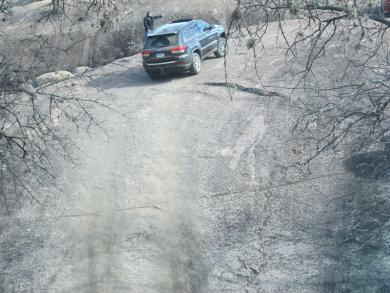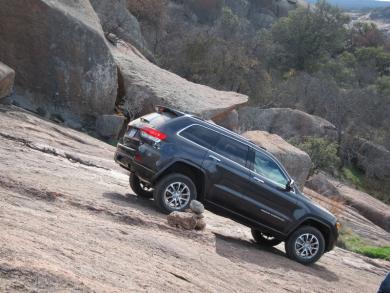Actually, the contrasting stitching is a feature found throughout the Grand Cherokee Overland interior, and for good measure, the seats are also piped, vintage British car (and modern Range Rover) style, and embossed (you’ll pay dearly for that from some other manufacturers) should you have to have it. Maybe a little much?
Maybe not. We also drove the V6 on the off-road course, where it exceeded expectations. Our hosts wanted to make the point that the Grand Cherokee is a rock-crawler in the full Jeep tradition, subjecting them to two courses with extreme ascents and descents, along with deep-sand dry river beds and sundry ditches and boulders.
The 2014 Grand Cherokee, even with piped seats, is no less adept at handling the tough stuff than previous generations. It’s better, in fact, what with the speed selectable hill ascent and descent feature and electronics to help manage traction requirements. We came out of water, for instance, and headed almost straight up a steep rocky incline with no wheel slip at all; we climbed a steep rock face that truly looked impossible to ascend, and descended the other side at an angle that had us pressed into our seatbelts. Granted, the Grand Cherokee’s front fascia was removed, but that’s standard practice.
  2014 Jeep Grand Cherokee. Click image to enlarge |
Will typical owners subject their Grand Cherokees to this? A handful, I expect. But nonetheless, a Jeep Grand Cherokee has to deliver the off-road goods if the brand is to maintain its authenticity. Even if you’re not going to bash your new Grand Cherokee over tree stumps and rocks, or crash through forest trails, one supposes that owners gain satisfaction from knowing that if they needed to, they could.
We drove back to Austin in a diesel-powered Overland. The 3.0L V6 engine is sourced from Italian maker VM Motori Cento (Fiat owns Jeep now) and as mentioned above, is being made available to Overland and Summit buyers for $4,995 over the V8 price. This engine pulls like a locomotive from standstill with its output of 240 hp at 3,200 rpm and 420 lb-ft torque at 2,000 rpm (both the 5.7L V8 and 3.0L EcoDiesel will tow 3,266 kg/7,200 lb; the 3.6L V6 is rated for 2,812 kg/6,200 lb).
The diesel is exceedingly quiet on the highway, although it generates a background hum at idle or when driving around town. Personally, I don’t mind the muted diesel clatter when it’s operating at low speeds; it sounds brawny and capable to me, and fully in character. And why go diesel? We achieved 8.1 L/100 km on the highway, which is excellent fuel consumption for a vehicle of this type.
For me, given the Grand Cherokee’s ability to traverse extreme terrain, it’s fair to describe it as a high-performance vehicle in the world of off-roading. Of course, Jeep has another high-performance vehicle in its stable: the SRT.









